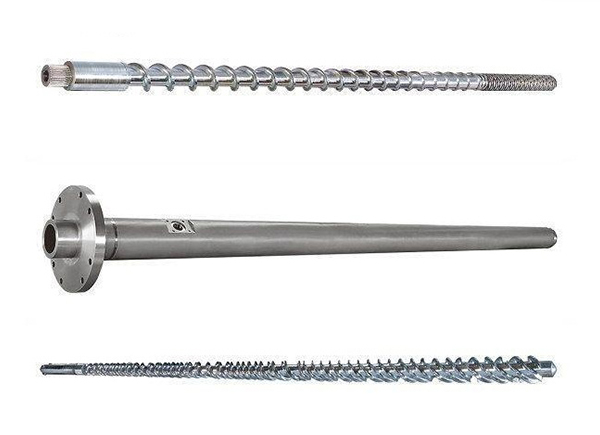+86-0580-8052088
+86-13505800981
No. 20, Liguan Road, Jintang Town, Dinghai District, Zhoushan, Zhejiang, China
(1) Screw data 1. Requirements for raw materials I […]
(1) Screw data
1. Requirements for raw materials
It can be known from the extrusion process that the screw is operated under high temperature, certain corrosion, intense wear, and high torque. Therefore, the screw must:
1) High temperature resistance, no deformation under high temperature;
2) Wear resistance and long life;
3) Corrosion resistance, the material is corrosive;
4) High strength, can accept high torque and high speed;
5) Has a very outstanding cutting function;
6) After heat treatment, the residual stress is small, and the thermal deformation is small.
2. Common information and heat treatment
Now the commonly used screw materials in our country are No. 45 steel, 40Cr, ammoniated steel, 38CrMOAl, etc.
1) No. 45 steel is cheap and has good processing functions, but it has poor wear resistance, corrosion resistance and aging resistance.
Heat treatment: quenched and tempered HB220-270, high-frequency quenching HRC45-48
2) The function of 40Cr is better than that of No. 45 steel, but it is often plated with a layer of chromium to improve its corrosion resistance and wear resistance. However, the requirements for the chromium plating layer are relatively high. If the plating layer is too thin, it is easy to wear, and if it is too thick, it is easy to fall off. After falling off, it will accelerate the corrosion. Now it is less used.
Heat treatment: quenched and tempered HB220-270, hard chrome plating HRC>55
3) Nitrided steel and 38CrMoAl have excellent comprehensive functions and are widely used. Generally, the nitride layer is 0.4-0.6 mm. But this kind of material has low resistance to hydrogen chloride corrosion, and the price is higher.
Heat treatment: tempering HB220-270, nitriding HRC>65
Titanium carbide coating is used abroad to improve the corrosion resistance of the screw surface, but it is reported that its wear resistance is not good enough. In recent years, foreign countries have adopted a series of methods to improve the wear resistance and corrosion resistance of the screw. One way is to select highly wear-resistant and corrosion-resistant alloy steel. Such as 34CrAlNi, 31CrMo12, etc. There is also a method of spraying Xaloy alloy on the surface of the screw. This Xaloy alloy has high wear and corrosion resistance (see the barrel section for details).
(2) Calculation of the strength of the screw
When the screw is matched with the main shaft of the gearbox with a longer cylindrical surface, the screw can be used as a cantilever with one end fixed. The force status of the screw in the extrusion process can be simplified to the following conditions:
1. Screw force status
1) Self-weight G;
2) Torque M required to overcome material resistance;
3) The axial force P generated by the material pressure.
Screws are generally obsolete due to long-term wear, and the gap between the screw and the barrel is too large and cannot be extruded normally. However, there are also cases where the stress exceeds the strength limit due to improper planning or operation. Therefore, the screw should also meet certain strength requirements.
4) The risk profile of the screw is generally at the smallest thread root diameter in the feeding section.
2, strength calculation
According to data mechanics, for plastic data, the compound stress is calculated by the third strength theory
3, other conditions
1) Regarding the floating connection between the tail of the screw and the main shaft of the reduction box, because the screw is floating in the barrel, the bending stress caused by the screw's own weight is equal to zero, so the calculation is only based on the compression stress and shear stress of the screw.
2) Because the bending stress caused by the weight of the screw is very small (the material around the screw is filled), even in the former case, it can be omitted, so the two methods are actually the same.
3) There is also a pure twist to estimate the screw diameter.

Copyright:Zhoushan Tianxiang Screw Factory
China Conical Twin Screws ManufacturersTechnical Support: HWAQ